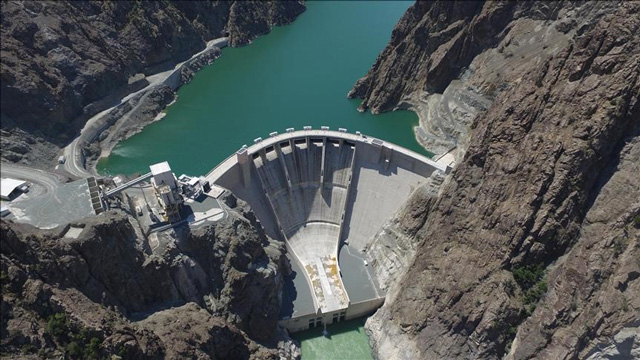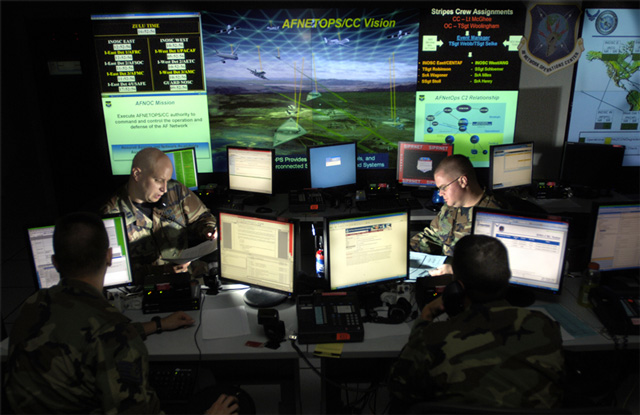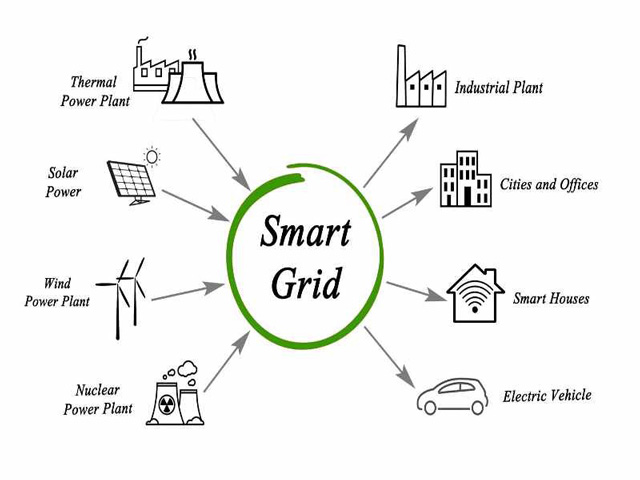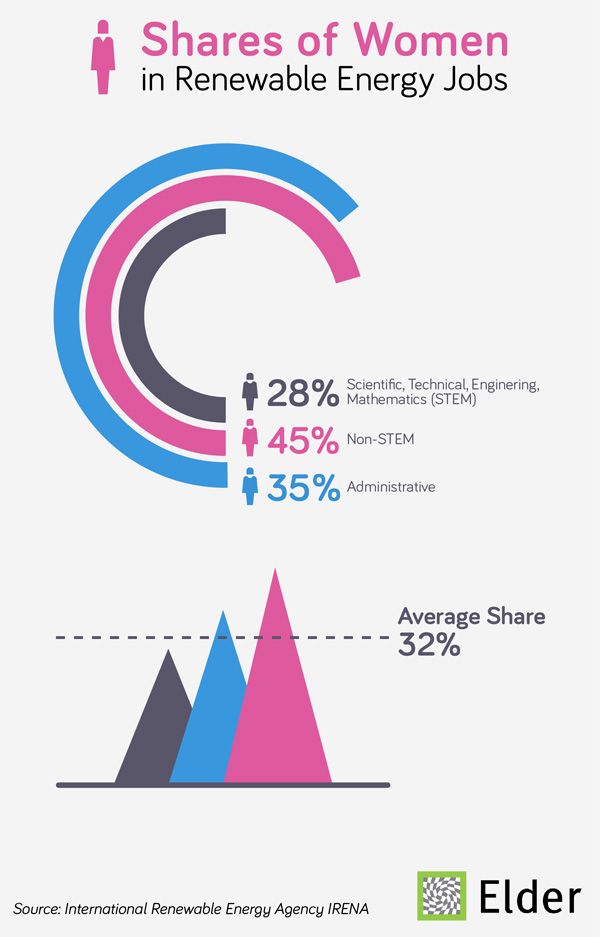
A new dam and hydroelectric power plant will pump some 450 million Turkish liras ($83.5 million) into Turkey’s economy every year, the country’s president said on Thursday.
The Yusufeli Dam in Artvin, northeastern Turkey will produce some 1.9 billion kilowatts per hour, Recep Tayyip Erdogan told a campaign rally and ribbon-cutting ceremony ahead of the March 31 local elections.
Underlining that some 26 billion liras ($4.8 billion) had been invested in the province in the past 17 years, under the rule of his Justice and Development (AK) Party, Erdogan also said recent upgrades to a border crossing with neighboring Georgia had recently been completed.
He also touted other recently completed projects in the fields of education, sports, and health.
Source: AA

Turkish energy company Polyak will be provided with a grand incentive for its new investment in a thermal power plant with an annual capacity of 708 megawatts (MW), to be established in the western province of İzmir.
An incentive certificate amounting to TL 3.47 billion has been given to Polyak Eynez Enerji for its investment in a completely new thermal power plant based on domestic coal.
According to the 2018 December investment incentive certificate list published in the Official Gazette yesterday, the Social Security Institution (SGK) employer's share support, tax relief, customs duty exemption and interest support and value-added tax (VAT) refund and exemption will be provided for seven years for Polyak Enerji's annual 708-MW thermal power plant.
According to the list, in December, 405 investments with a fixed investment amount of TL 14.7 billion were given incentive certificates that were granted various tax exemptions.
The Assan Aluminum company was granted an incentive certificate for its extended investment in a facility in Gebze amounting to TL 2.1 billion and capable of producing 96,720 tons of aluminum sheets and 77,919 tons of foils a year; Lodos Karaburun, an electricity production company, was granted an incentive certificate for its extended investment in a renewable energy systems production facility in İzmir amounting to TL 761.7 million and capable of producing 265 MW of energy every year, and Turkish clothing store chain LC Waikiki was granted an incentive certificate for its logistical services investments in Yalova amounting to TL 534.9 million, with a capacity of 120,000 pallets every year. The incentives give various tax and premium exemptions.
Source: Daily Sabah

Total annual investment in the off-grid energy access sector surpassed $500 million in 2018, according to a new report from Wood Mackenzie Power & Renewables and Energy 4 Impact.
Strategic Investments In Off-Grid Energy Access: Scaling the Utility of the Future For the Last Mile highlights the rapid acceleration in investment across the energy access sector. Nearly $1.7 billion in cumulative disclosed investment was deployed into energy access markets by the end of 2018, with over $1.2 billion deployed since the beginning of 2016.
In 2017, year-on-year transaction volume grew 37% and total capital composition by volume shifted to over 50% debt, signalling scale-up and further maturation of the sector. In 2018, total transaction volumes grew another 22% year-on-year, and the average equity investments doubled and debt increased nearly 5.5x.
Commenting on the report, Benjamin Attia, Wood Mackenzie Power & Renewables Analyst and lead author, said: “Investments in the energy access space have accelerated rapidly in the last few years but total volumes still fall well short of the total estimated financing needed to reach universal electricity access globally by 2030. The pace and manner at which electricity is provided to almost 1 billion people who still do not have access to energy will have a dramatic impact on power demand, electricity generation, grid infrastructure investments and future carbon emissions reductions.
“This emerging sector has seen a steep uptick in investments and partnerships from strategic groups within many of the oil and gas majors, European utilities and IPPs, clean energy OEMs, and the technology sector looking to capitalise on new opportunities in fast-growing emerging economies. As the off-grid energy access sector begins to mature, strategic investors will deeply shape the market’s trajectory and redefine the customer-centric utility business model yet again by expanding service offerings beyond a basic electricity connection. Ultimately, the energy access opportunity represents the prospect of ‘owning’ the next billion customers, their evolving needs and their data.”
Peter Weston, Energy 4 Impact Director of Programmes, said: "Strategic investors are playing an increasingly important role in the off-grid sector, attracted by the size and potential growth opportunities in the market. Most of the interest so far has been in pay-as-you-go solar home system companies, although there have also been some notable investments in mini-grids as well.
“Engie's recent acquisition of Fenix is one of the first successful exits in the sector and illustrates the market is becoming more mature. However, there is a still a long way to go and it will be important for donors and NGOs, such as Energy 4 Impact, to continue supporting the sector and creating an enabling environment to encourage further investments."
Particularly for utility-minded strategic investors like Engie, Shell, EDF, and Total, there is strong interest in evolving the utility business model beyond electricity service provision. Leading distributed energy service companies and their strategic partners are experimenting with ‘value-stacking’ add-on services like internet, water, productive appliances, financial products and services, and other retail goods.
According to the report, 75% of all strategic activity in the off-grid energy access sector is commercial in nature. Of that figure, direct investments and M&A represent nearly 25%. Strategic investors and their affiliates have made or been involved in over 110 direct investments in the energy access sector - worth over $383 million in disclosed value.
Strategic investors have formed over 30 partnerships and joint ventures with off-grid energy access companies. These allow a diverse array of technical partners and the leveraging of internal resources, such as R&D and marketing. Many are also motivated by strategic plans or targets to operate in multiple markets by 2030.
Strategic investors have also participated in indirect fund investments worth over US $461 million. Most of these investments by volume are into funds managed or created within or alongside the corporate structure of the investor, and allow the investor to learn from a broad set of vendors across different product categories, geographies, and scales.
“An investment cliff could be looming in the short-term future of the sector, particularly for pay-as-you-go solar home systems. Capital concentration by company, technology, geography and business model, paired with aggressive growth expectations from VCs and few successful exits to date, leads to some outsized macro-level risks that may cause a dip in annual investment in 2019.
“More broadly, in the face of the risk and reward of unbundling, the energy access sector in general and the SHS sector in particular may face a slight identity crisis in the near-term. Are they ultimately energy service providers or utilities? Are they ultimately consumer finance institutions? Retail product sales? Or all of the above?” added Mr. Attia
Source: Wood Mackenzie

The German electric vehicle (EV) industry will see an investment of over €40 billion over the next three years, and the number of models produced in Germany is set to triple, to over 100 in that period.
That’s the word from the President of the country’s auto industry association, the “Verband der Automobilindustrie (VDA).
VDA President Bernhardt Mattes, said: “We will invest over €40 billion ($45.5 billion) in electric mobility during the next three years, and another €18 billion ($20.5 billion) will be invested in digitization and connected and automated driving,” with the announcement coming ahead of the industry’s biggest annual event, the Geneva Motor Show.
Germany, as well as some other strong EU economies, are set to have above average adoption rates of EV’s, he added.
“The ramp-up of electric mobility is coming in Europe,” Mattes added. “Without it, the EU’s CO2 targets cannot be achieved by 2030,” he added, adding a call for the necessary regulatory conditions across Europe.
At the same time, domestic car production is expected to drop by 5% in the country in 2019 as a result of a slowing economy, trade risks linked to US tariffs, and the growth of production facilities in countries like Mexico, USA, and China, warned the VDA chief.
He further called for the incentivisation of EV purchases, and the expansion of charging infrastructure.
Source: Smart Energy International

European power grids have long been considered as potential targets for major cyberattacks given the enormous damage they could inflict. Successful cyberattacks against power grids could not only cause societal and economic disruptions, but also put a dent in the military readiness of European countries. In the event of a blackout, the lights could go out in town halls and military facilities alike. Lukas Trakimavičius explains how micro grids can ensure the stable operation of military assets.
In recent years most European power providers have embraced large scale digitization. Companies increasingly began to rely on sophisticated industrial control systems, which allowed to cut operational costs and boost efficiency. A great deal of this new hardware was also connected to the Industrial Internet of Things which made the equipment “smarter” and even more performance-oriented.
Unfortunately, much of this equipment was built not necessarily with security in mind. Volumes of evidence suggest that the hardware often lacks adequate security protocols, runs on outdated software and frequently suffers from poor network security configurations. Today, a targeted search engine such as Shodan can uncover thousands of publicly accessible logins to equipment that is connected to the internet.
A number of serious cyberattacks against power grids have already highlighted the gravity of these security vulnerabilities.
In 2015, a hacker group attacked the industrial control systems of an electrical grid in Ukraine, which left around 225,000 residents in the dark for up to six hours. A year later, another cyberattack successfully compromised the Ukrainian power grid, took control of some of its industrial control systems, and cut a fifth of Kyiv’s power for about an hour. While both of these cyberattacks caused only temporary supply disruptions, it took months for the control stations to fully recover.
Although much ink has been spilled discussing the societal and economic risks of cyberattacks, arguably too little attention has been paid to the military’s acute dependency on an intermittent supply of electricity. There is considerable concern that a sufficiently powerful cyberattack against a central power grid of a European country could disrupt the operational capacity of its military facilities, bases and other strategic assets.
Fortunately, partial decentralization of power grids through the introduction of micro grids could potentially help strengthen energy resilience. Micro grids are basically scaled-down versions of regular power grids that in combination with distributed energy generation units are frequently used to provide electricity to remote areas. In addition to working independently from the main power grids, micro grids can also operate in parallel with them.
Given their capacity to operate independently from the main power grid, micro grids can help ensure a continuous supply of electricity even in the event of a crippling cyberattack. If the hackers manage to take down the main grid, the micro grid can disconnect itself from the main grid and, by relying on either local or on-site energy sources such as solar or wind power, it could continue to work relatively unharmed.
Therefore, if a military facility would be connected to a micro grid, it is much more likely that it could successfully weather a cyberattack (or any other disruption for that matter) without having its operational capacity impaired.
Source: Energy Post EU

The Energy Networks Association seeks views on how to design a GB smart grid. It has published a Baringa Partners impact assessment of the five ‘future world’ scenarios set out last summer.
Those scenarios range from a system where distribution networks act as system operators and call the shots, to one where the electricity system operator (National Grid) retains command, with stages in between where the regional and national system operators co-ordinate around procurement and dispatch of flexibility.
All worlds require greater flexibility. Baringa’s assessment favours ‘world B’ as a least regrets initial pathway.
Taking that path enables flexibility to play a key role in managing and balancing the UK’s power networks, while giving sufficient scope to diverge to any other ‘worlds’ around 2023, when the impact of Ofgem’s charging and access reforms is better understood.
Energy Networks Association chief executive said that approach was “pragmatic”, enabling network operators to continue their current trajectory, while “leaving the door open to more radical changes in the future”.
The ENA has published detail of the impact assessments and via a consultation, seeks views on its proposed approach.
Source: The Energyst
Renewable Energy: A Gender Perspective
Renewable energy employs about 32% women, compared to 22% in the energy sector overall. Still, within renewables, women’s participation in science, technology, engineering and mathematics (STEM) jobs is far lower than in administrative jobs.
This report from the International Renewable Energy Agency (IRENA) examines the question of gender equity throughout sector. Building on a ground-breaking survey of employees, companies and institutions, it finds that much remains to be done to boost women’s participation and allow their talents to be fully utilised.
IRENA estimates that the number of jobs in renewables could increase from 10.3 million in 2017 to nearly 29 million in 2050. The ongoing global energy transition offers the chance to create new jobs and reshape all aspects of how energy is produced and distributed.
Renewables offer diverse opportunities along the value chain, requiring different skill sets. But these opportunities should be equally accessible, and the benefits equitably distributed, the report notes.
Please click here to read the full report.

